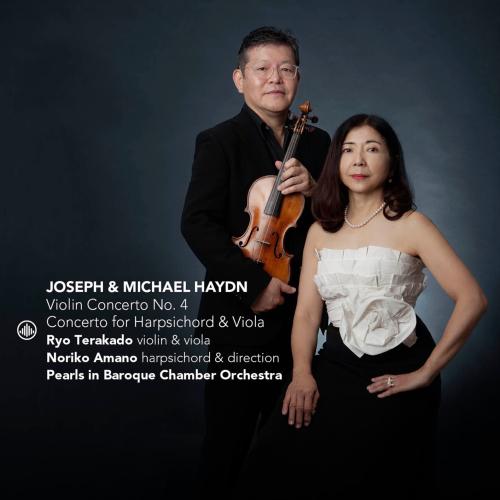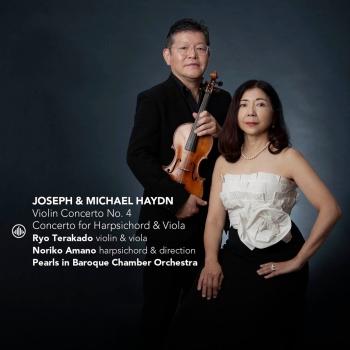
Joseph Haydn: Violin Concerto No. 4 / Michael Haydn: Concerto for Viola and Harpsichord Noriko Amano, Ryo Terakado & Pearls in Baroque Chamber Orchestra
Album info
Album-Release:
2023
HRA-Release:
02.02.2024
Label: Challenge Classics
Genre: Classical
Subgenre: Concertos
Artist: Noriko Amano, Ryo Terakado & Pearls in Baroque Chamber Orchestra
Composer: Joseph Haydn (1732-1809)
Album including Album cover Booklet (PDF)
- Joseph Haydn (1732 - 1809): Violin Concerto No. 4, in G Major (Hob. VIIIa/4):
- 1 Haydn: Violin Concerto No. 4, in G Major (Hob. VIIIa/4): I. Allegro Moderato 09:31
- 2 Haydn: Violin Concerto No. 4, in G Major (Hob. VIIIa/4): II. Adagio 06:22
- 3 Haydn: Violin Concerto No. 4, in G Major (Hob. VIIIa/4): III. Prestissimo 03:49
- Concerto for Harpsichord and Viola in C Major (P 55, MH 41) :
- 4 Haydn: Concerto for Harpsichord and Viola in C Major (P 55, MH 41) : I. Allegro Moderato 12:59
- 5 Haydn: Concerto for Harpsichord and Viola in C Major (P 55, MH 41) : II. Adagio 10:18
- 6 Haydn: Concerto for Harpsichord and Viola in C Major (P 55, MH 41) : III. Allegro 08:18
Info for Joseph Haydn: Violin Concerto No. 4 / Michael Haydn: Concerto for Viola and Harpsichord
Joseph Haydn (1732–1809) wrote four violin concertos, only three of which survive (No. 2 is lost). One of them is the Violin Concerto in G Major, Hob. VIIa/4, also known as Violin Concerto No. 4. It was composed around 1769, when he was the Kapellmeister at the Esterházy court. The style is typical of Haydn’s concertos of this period: very similar, for example, to his Cello Concerto in C Major. The orchestral scoring is for strings only. In this concerto, Haydn offers a full exposition of the aspects and attractions of the violin with elegant simplicity.
Michael Haydn (1737–1806) was one of the most accomplished composers of church music in the later 18th century. He was the younger brother of Joseph Haydn and an intimate friend of Wolfgang Amadeus Mozart (1756–1791). The Concerto for Harpsichord (or Organ) and Viola is an early work that was composed between the years 1757 and 1762 when Haydn was Kapellmeister to the bishop of Grosswardein in Hungary (now Oradea in Romania).
The combination of harpsichord and viola is very rare in Baroque music. Although Michael Haydn could have considered pairing, for example, the violin and the harpsichord, the warm sound of the viola supports the harpsichord perfectly well.
Ryo Terakado, violin, viola
Noriko Amano, harpsichord, conductor
Pearls in Baroque Chamber Orchestra
Ryo Terakado
was born in 1961 in Santa Cruz, Bolivia. He started to play violin at the age of 4, and won 2nd prize in the All Japan Youth Musical Competition when he was 14. Ryo studied violin, chamber music and conducting at the Toho Gakuen School of Music. In 1983, he took third prize in the All Japan Music Competition. Upon graduating from Toho Gakuen, he was invited to become concertmaster of the Tokyo Philharmonic Orchestra, a position he held for two years.
Meanwhile, Ryo’s interest in Baroque music had been developing for some time: at the age of 19, he started to teach himself Baroque violin, and in 1985, he moved to the Netherlands to study the instrument at the Royal Conservatory in The Hague under the guidance of Sigiswald Kuijken, receiving a soloist diploma in 1989.
Since 1987, he has performed as concertmaster with Baroque orchestras in Europe and Japan including La Petite Bande, Les Arts Florissants, La Chapelle Royale, Collegium Vocale Gent, and Tokyo Bach Mozart Orchestra; he made regular appearances with these orchestras to perform the concertos of composers including Bach, Vivaldi and Mozart. Ryo is also the current concertmaster of Bach Collegium Japan, and is invited frequently to Italy, Poland, France and Australia as a soloist. Since 1994, he has been one of the featured artists in the Hokutopia International Music Festival in Tokyo, where he made his debut as a conductor. His repertoire as a conductor includes operas by Monteverdi, Purcell, Rameau, Gluck, Haydn and Mozart.
Ryo is a faculty member of the Hague Royal Conservatory (Holland), The Royal Conservatory in Brussels and his alma mater, Toho Gakuen School of Music (Japan). He teaches regularly at Yonsei University in Seoul and makes concert appearances in Korea.
His discography can be found on the Ricercar (Belgium), Accent (Germany) BIS (Sweden) and Denon (Japan) labels.
Noriko Amano
was born in Tokyo and studied piano at Toho Musical College. After graduation, she enrolled at Tokyo’s Keio University to study Musical History and Musical Aesthetics, graduating in 1988. A few years later, Ms. Amano came to the Netherlands to study harpsichord at the Royal Conservatory of The Hague and Sweelinck Conservatory of Amsterdam. She received her U.M. Soloist Diploma in 1996. She has played in ensembles and solo in Europe and Japan, and has made several recordings to very positive reviews. Many reviewers have commented that they have never heard such musical and lyrical playing on harpsichord before, remarking that there was also something spiritual about her playing.
In addition to playing German and Italian baroque pieces, Ms. Amano specializes in French 17th century music. She played a program with La Compagnie Baroque, dedicated to the oeuvre of Elisabeth Jacquet de la Guerre (see above). Recently she made a well-received live broadcast from the renowned Concertgebouw in Amsterdam.
She married to Robbert van Baaren whose great uncle Kees van Baaren was the father of Dutch 20th century composition. Then main concert hall of the Royal Conservatory in The Hague bears his name.
The Japanese composer Yayoi Ota composed for Noriko Amano a piece for harpsichord and Shinto flute (Ryuteki) called “Tairakeku Yasurakeku”.
She performed the World première of this compostion in 2017 in Tokyo.
Noriko Amano is artistic director of Pearls in Baroque, a platform for baroque music and art she established in 2019.
Booklet for Joseph Haydn: Violin Concerto No. 4 / Michael Haydn: Concerto for Viola and Harpsichord











